.jpg )
Invincible; that’s how you feel. With the supercharged V6 engine growling each time you flex your right foot, and the Dick Cepek tyres crawling through the mud and ruts of the test track, you feel this vehicle could take you anywhere; which is just as well, since it’s built to drive, unsupported, to the South Pole, where it aims to beat the world record.
This feature was originally published in 4x4 Australia’s March 2012 issue
The South Pole seems a long way from this test track, set in the wooded grounds of the Brands Hatch race circuit in England where recent rain has provided a generous covering of sticky mud. These are familiar conditions when off-roading in England, and no problem for the Polar TRV, but they are nothing to what the man next to me has experienced.
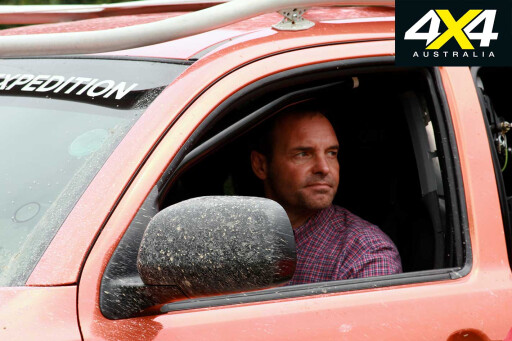 Driver and expedition leader Jason De Carteret is remarkably relaxed. He seems perhaps a little distracted at times, but then he has a lot on his mind, and the humps and bumps we are so enjoying seem insignificant to him. His life story reads like an action hero character in a pulp-fiction thriller.
Driver and expedition leader Jason De Carteret is remarkably relaxed. He seems perhaps a little distracted at times, but then he has a lot on his mind, and the humps and bumps we are so enjoying seem insignificant to him. His life story reads like an action hero character in a pulp-fiction thriller.
De Carteret has skied to the South Pole four times; leading expeditions there for Special Forces troops. Previously there were expeditions to the North Pole, endurance dog-sled racing in Alaska, career cave-diving in the Bahamas and five years as a helicopter pilot in southern Africa relocating wild animals under threat from poachers.
It all started when he drove a Land Rover from the UK across the Sahara, through central Africa and down the east coast, some 23,000km, to Zimbabwe. On arrival, he donated the Land Rover to the Rhino anti-poaching unit and then went to work with them. He’s run both team and solo expeditions in over 92 countries and he’s a popular motivational speaker. Point taken: no need for heroics with his vehicle, then.
The project began when he was approached by Thomson Reuters to provide a ‘money-cannot-buy’ prize for a global competition the company was running. Thomson Reuters claims to be “the world’s leading source of intelligent information for businesses and professionals”.
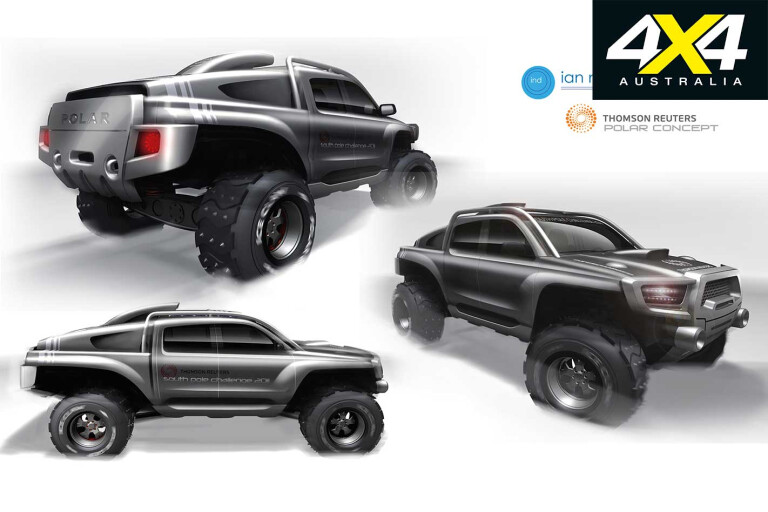
Down on planet earth, it’s difficult to comprehend what that actually means, but the company employs over 55,000 people in 100 countries, and in 2010 reported revenues of US$13.1billion. These guys deal with financial information on an unfathomable scale.
They approached De Carteret and his suggestion was for the winner to be part of an expedition to actually drive to the South Pole and beat the existing world record for an unsupported motorised vehicle. A record held by Jason De Carteret.
Back in 2004, when he returned from one ski trip to the South Pole, De Carteret came across a group of Land Rovers about to embark on the journey. He was somewhat dismayed to see the minimal modifications. In his words “all they’d done was fit a set of sand tyres.” They travelled nine kilometres before they were rescued and towed back.
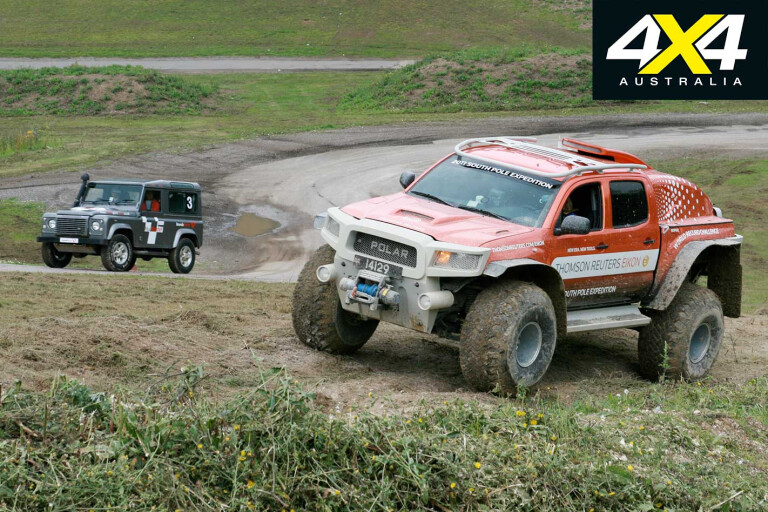
Their failure was Jason’s stimulus to build his own vehicle to do the journey and, perhaps bizarrely to those of us with no understanding of the conditions, led to him building a six-wheeled Chevrolet minibus run on biofuel. This unlikely vehicle smashed the existing 24-day record for a motorised trip to the South Pole, to two days, 21 hours and 21 minutes.
That is now the target for the Polar TRV, and the knowledge and experience from this first success has done much to decide the specification of the vehicle for this trip. Equally important is timing.
December would mark 100 years since Norwegian polar explorer Roald Admunsen became the first person to reach the South Pole – beating in the process the ultimately tragic expedition of Britain’s Captain Robert Falcon Scott. The aim for the Polar TRV, therefore, was to leave the base at midday on Sunday December 11, 2011, to arrive at the South Pole exactly 100 years after Admunsen.
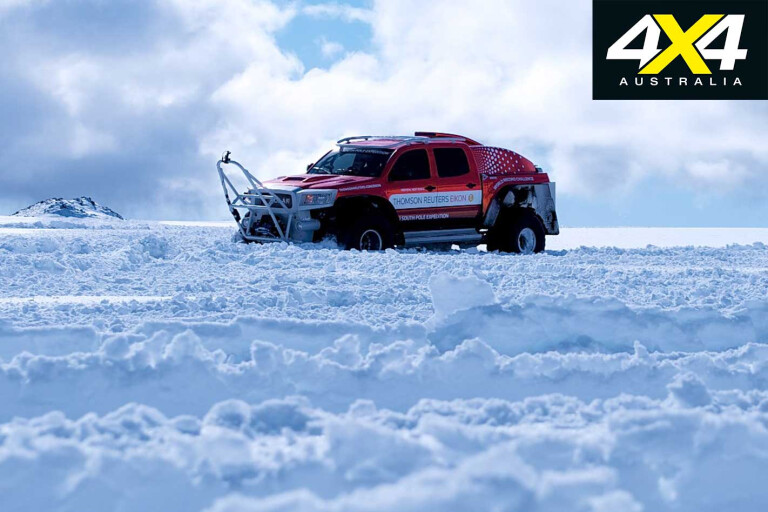
Originally, after seeing the failure of the Land Rovers in Antarctica, De Carteret considered a six-wheel drive necessary. But this meant a very heavy vehicle with high fuel consumption. The size of the vehicle also meant a huge underbody area to clog with snow and ice; restricting movement, adding weight, and increasing fuel consumption. This led to a significant shift in his plans, and the result is the vehicle you see here.
The base vehicle is a US-spec Toyota Tacoma. Otherwise, this is a very British expedition. Driven by Jason and funded completely by Thomson Reuters, the vehicle is without the massive corporate branding one might expect from such a project. Succeed, or fail, Polar TRV is the result of a small talented team of Brits, and Thomson Reuters must be given credit for supporting this.
The original-spec Tacoma comes with a 4.0-litre V6 quad-cam engine that delivers 176kW. Pretty good for US dirt roads, but not for Antarctica. De Carteret decided to add the tried-and-tested supercharger package produced by Toyota’s performance and motorsport division, TRD. This is a popular and successful conversion in the US, using an Eaton Roots-type supercharger, which is compact and doesn’t require any bodywork modifications.
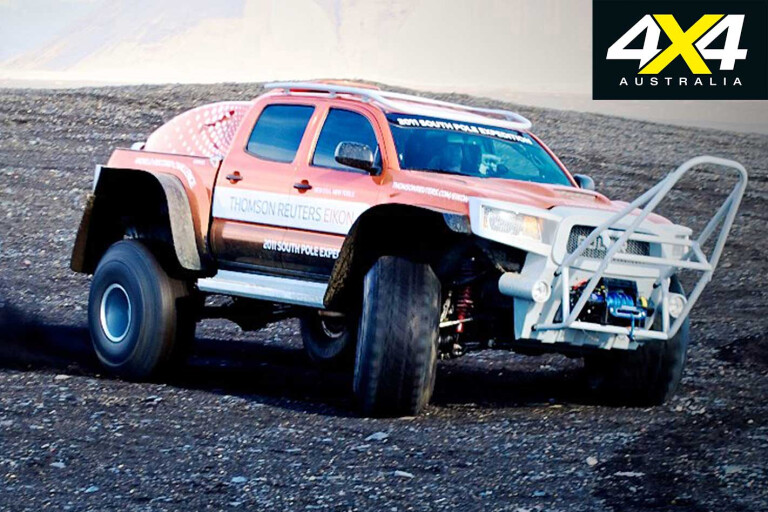
The one-piece supercharger plenum/manifold casting has the heat exchanger core for the intercooler located inside the plenum section of the manifold. TRD claims that by using the intercooler, the inlet temperature to the engine is reduced allowing use of a more aggressive ignition timing map with the relatively high 10:1 compression ratio for the V6 engine.
This results in better engine response (something we can vouch for) and improved power output. It also provides better resistance to detonation and a greater safety margin under severe use. For the Polar TRV the plan to use biofuel meant TRD had to re-map the ECU, and change the injectors so they could ‘double pulse’ when the engine needed full power – now around 300kW – and a lot more (undisclosed) torque!
Next stop for the now fully-tuned Tacoma was Iceland, and the workshop of Arctic Trucks. These guys are known for building specialised vehicles for both the North and South Poles.

The Tacoma’s front axle was moved forward, and the rear back, to improve approach and departure angles. The drivetrain was strengthened, with the propshafts replaced by heavy-duty custom-made units. Front and rear axles have ARB Air Lockers fitted. The rear suspension was changed from the standard leaf spring live axle to a five-link (four trailing arms plus panhard road) coil-sprung live axle, thus providing coil-spring suspension all round. Dick Cepek wheels and 44-inch Fun Country tyres complete the set-up, with the Tacoma’s shell receiving a full internal and external roll cage and other structural strengthening.
The vehicle then returned to the UK to get the specialised attention De Carteret demanded. For this he turned to Kieran Bradley, an engineer at British sports car manufacturer, Lotus. Lotus has supported De Carteret’s previous projects and so, before he had bought the Tacoma, he asked the company to design a vehicle to break the world record. However, the proposed cost and build time saw De Carteret change tack and contact Ian Nisbett Design.
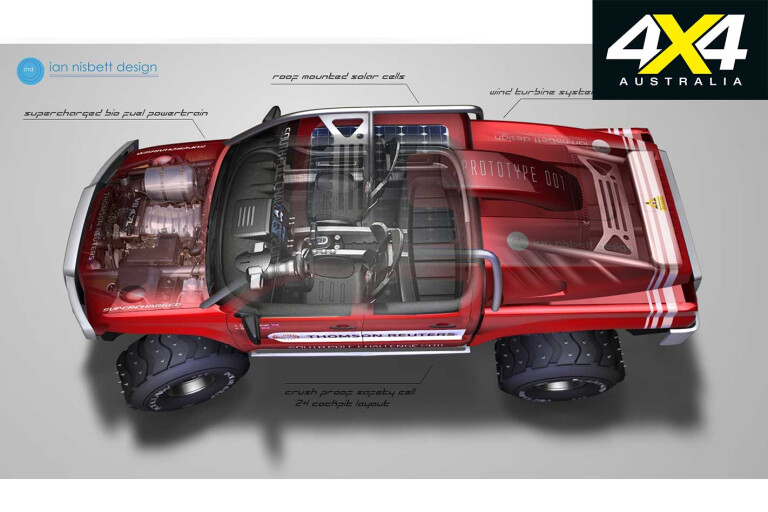
Ian’s design knowledge and off-road experience from the sand dunes of North Africa saw him take the Tacoma and Jason’s brief, and produce this stunning vehicle. The large, cutaway wheel arches should allow much of the snow and ice to fall away.
The external roll cage will also carry solar panels for additional power and even the rear cover has a small roof scoop at the top, which will include wind power generators. When we drove the vehicle, much of the interior remained standard – including the Toyota steering wheel and the nasty US-plastic facia and heater controls. The latter was superfluous as heat from the engine would dissipate long before it made it into the cabin. The cab would remain a ‘toasty’ -20C, heated only by the body warmth of the occupants.
The front and rear panels of the Polar TRV have been designed by Ian Nisbett, and fabricated by Kieran Bradley. The Lotus engineer also hand-built and TIG-welded the two additional 400-litre baffled fuel tanks that fit under that rear cover.

Bradley will be joining De Carteret on the trip to the Pole, along with the winner of the Thomson Reuters competition – a Canadian who goes by the name of JT. JT’s a big guy and has been told to lose no less than 22kg of weight by De Carteret otherwise he’s not getting in the vehicle.
The final weight of the vehicle, according to De Carteret, should be around 2600kg. No-one was prepared to comment on the overall budget for this project, but it is estimated the cost of the vehicle alone is probably around US$200,000.
Getting into the vehicle is not easy. Grabbing the A-frame post of the internal roll cage, you haul yourself into the high-up, tight fitting carbonfibre race seats. You then thread both feet between the seat and roll cage. Large competition three-point belts hold the occupants firmly in place and it all seems remarkably comfortable and civilised.
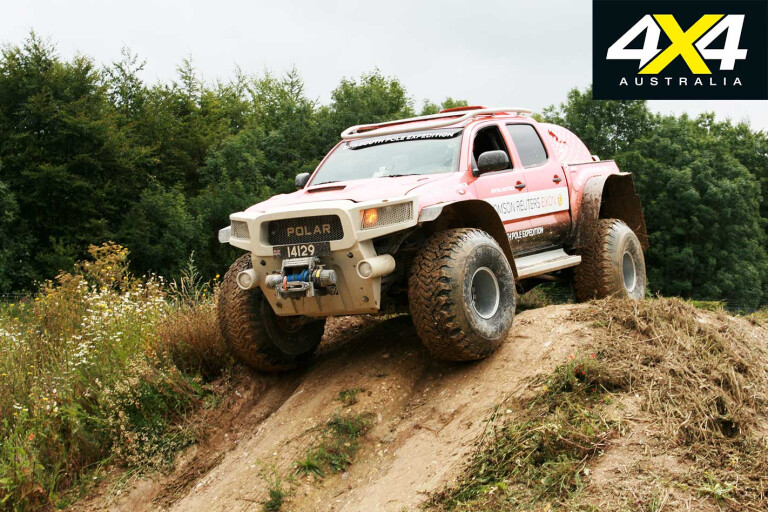
Besides the standard steering wheel and plastic facia, there’s also a large GPS plotter, and a smaller digital computerised fuel gauge for the driver. Fuel being a vital ingredient to the success of the trip, this is no simple gauge but a complex recording of exactly what is being consumed, right down to the performance of individual injectors.
The supercharged V6 has a bespoke side-exit exhaust system designed and fabricated by Kieran Bradley. Whether the aural nature of the design was part of the brief is unclear, but boy does it sound great.
What is more surprising is that, despite the lion-like roar, the Polar TRV can be driven in a more gentle kitten-type fashion. Throttle control is amazing, the response instant and the power delivery oh-so-smooth. That in itself bodes well for a brilliant off-roader, and the Polar TRV doesn’t disappoint – it thrills. Axle articulation is so good, and the vehicle’s ride so unexpected that the ruts and ravines of the Brands Hatch off-road course are irrelevant.
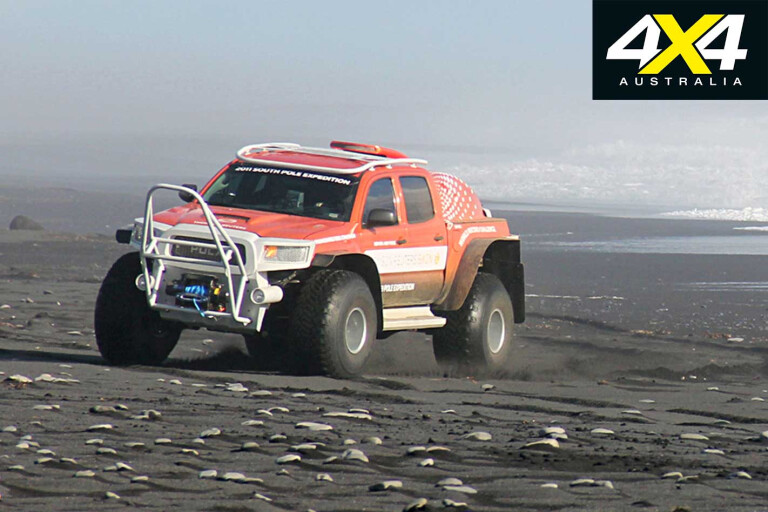
We complete the whole course in high-range (the vehicle still has the standard Tacoma automatic four-speed box, but with different ratios) with only the rear diff locked. Locking the front would have restricted the vehicle’s turning circle even further, and to be honest it is difficult at times to thread the beast along tracks normally covered by diminutive Land Rovers!
Cross-track ruts could be taken at speed, but we have to curtail our enthusiasm – remembering who is in the cab with us, and where this vehicle is going! The steep downhill section necessitated a dab on the brakes – which may not have been needed in low-range – and the balloon-like tyres are perhaps not ideal for the mud.
Overall, there is an ease to driving the Polar TRV which is no coincidence. To beat the record, they will travel constantly for two days and 20-something hours, continually changing drivers, continually jumping in and out of the vehicle to alter tyre pressures and check the conditions ahead. Having a vehicle that is reasonably easy to manhandle across the snow and rock-hard ice is essential.
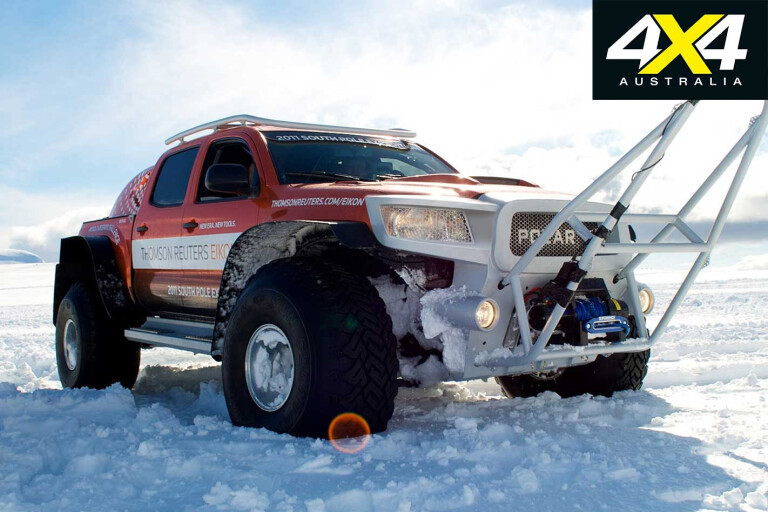
One hundred years ago, Scott reached the South Pole only to find a Norwegian flag and a letter from Roald Admunsen. After all they had endured, to finish second must have been soul-shattering. The experience ultimately cost them their lives.
Admundsen had made it to the Pole using dogs, while Scott’s team made it without support. Carteret, Bradley and JT will be alone in the high-tech, tough and capable Polar TRV. Nevertheless, the dangers remain, as Jason De Carteret explained: “We know this vehicle works, we know these tyres will work, but whether we get there… there are no guarantees. In Antarctica, as Scott proved, you can pay the ultimate price. When we are out there, we are on our own. Going to Antarctica, you have got to be prepared not to come back.”
Since this story was written, De Carteret’s team smashed the record to an amazing one day, 15 hours and 54 seconds.

COMMENTS